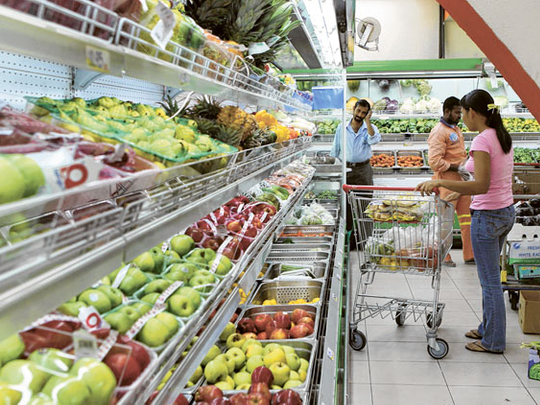
Dubai: Despite the Ministry of Economy’s attempt to curb soaring food prices across the UAE, the overall prices of fresh food in Dubai increased by 2.5 per cent during the month of Ramadan, according to Dubai Chamber’s Food Index.
The price movement continued its upward trend, this month at a rate of 2.5 per cent, which was slower than last month’s 3.9 per cent.
The index shows that the upturn was due to the price increase in three of the four fresh food groups, led by the price hike in fruit, at 9.2 per cent. Prices of fresh vegetables remained the same as that of the same period in the previous year.
Hamad Bu Amim, Director General, Dubai Chamber of Commerce and Industry, said: “Food security is a very important issue for the UAE. The country imports the vast majority of its food and so establishing strong partnerships with key food producing nations is vital.”
“Last year, UAE food consumption was valued at Dh26.5 billion and this is forecast to rise to Dh34.8 billion by 2016. At the same time per capita food consumption is expected to increase from Dh3,527 last year to Dh4,156 in 2016,” he said.
“Since 2007, UAE imports of prepared foodstuffs and beverages have increased by 17.8 per cent from Dh8.76 billion to Dh12.28 billion in 2011. The main imported products are food preparations, sugar, chocolate and products containing cocoa, bread and cakes, followed by flour, water, fruit juices and then meat,” Bu Amim said.
“The United States is the country which provides the most imports, with a 10.5 per cent share, followed by India (8 per cent), Saudi Arabia (6.2 per cent), the UK (5.4 per cent), Thailand (5.3 per cent) and then France (5 per cent),” he said.
On the other hand, overall fresh food’s month-on-month movement continued to follow a seesaw pattern. From price increases seen in the last month, price reductions were posted this month. It’ month-on-month inflation rate of -0.4 per cent was due to the decrease in prices in three of the four fresh food groups led by vegetables at -3.1 per cent. A price increase was seen only in fruit at 4.7 per cent.
UAE vulnerability to supply shocks is not uniform across commodities. Demand response, diversification and price volatility discussed the main drivers of world food prices and outlined the measures needed to ensure an adequate food supply worldwide, Azzeddine Azzam, an economist, told Gulf News.
“Moreover, food pricing policy should account for substitution and complementarity between food commodities.”
“Some 4.5 million hectare plots have been bought by countries including the Gulf to secure food and guarantee a regular food supply channel.”
Globally, enough food will be available if productivity is increased, food waste eliminated, trade barriers dismantled, and subsidies are targeted or scrapped, he added.












